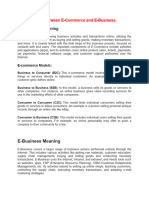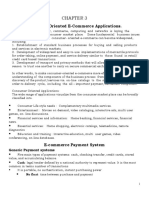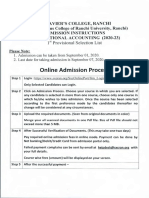UNIT 3
1. Explain mercantile process model from merchant perspective and consumer's perspective
The mercantile process model explains how e-commerce transactions occur in a structured
way, focusing on the interaction between merchants (sellers) and consumers (buyers)
From the Merchant's Perspective
1. Pre-Sales Activities
Goal: Attract customers and showcase products/services.
Actions: Setting up an online storefront (website or app).
Listing products with detailed descriptions, images, and pricing.
Marketing through ads, promotions, and email campaigns to drive traffic.
2. Purchase and Order Processing
Goal: Handle customer orders efficiently.
Actions: Receive the customer’s order.
Validate the order details (product availability, pricing, etc.).
Confirm payment through secure payment gateways.
3. Transaction Handling
Goal: Ensure secure and accurate financial transactions
Actions: Process payments via credit cards, digital wallets, or other methods.
Use encryption to secure financial data
4. Order Fulfillment
Goal: Deliver the product or service to the customer.
Actions: Ship physical products or provide access to digital products.
Update customers with tracking information and estimated delivery dates.
5. Post-Sales Activities
Goal: Retain customer trust and encourage repeat business.
Actions: Handle returns, refunds, or exchanges if needed.
Provide customer support for inquiries or issues.
Use feedback to improve services or products.
From the Consumer's Perspective
1. Pre-Purchase Activities
Goal: Search for and evaluate products or services
Actions: Browse the merchant’s website or app
Compare prices, read reviews, and check product details.
Add desired items to the shopping cart.
2. Purchase and Order Placement
Goal: Place an order for selected products.
Actions: Enter personal details (name, address, etc.).
Choose payment methods and complete the transaction.
Receive order confirmation from the merchant.
3. Transaction Verification
Goal: Ensure payment security and order accuracy.
Action: Receive notification about successful payment.
Cross-check the order details in the confirmation email.
4. Order Receipt
Goal: Get the product or service as expected.
Action: Track the shipment and wait for delivery.
Verify the product upon arrival or download the digital item.
� 5. Post-Purchase Activities
Goal: Provide feedback and resolve any issues.
Actions: Leave reviews about the product and shopping experience.
Contact customer support if the product is defective or unsatisfactory.
Repeat the process for future purchases if satisfied
2. Different electronic payment system (EPS)
Electronic Payment Systems (EPS) are digital systems that facilitate the transfer of money
electronically, making transactions faster, more secure, and often more convenient. Below are
different types of electronic payment systems:
1. Bank-Based EPS
Online Banking Transfers: Transfers conducted directly through bank websites or mobile
apps
Automated Clearing House (ACH): Batch-based processing system for direct deposits or
recurring payments.
Example: Example: Payroll, bill payments.
2. Card-Based EPS
Credit Cards: Enable users to borrow funds for purchases and pay later
Debit Cards: Linked directly to the user’s bank account for real-time transactions.
Prepaid Cards: Cards preloaded with a fixed amount for use until the balance is exhausted.
3. Digital Wallets
Store payment information for faster transactions.
Can hold multiple cards, bank account details, or prepaid balances.
Examples: PayPal, Google Pay, Apple Pay.
4. Mobile Payment Systems
Payments made through mobile apps or platforms
Examples: Venmo, Cash App, PhonePe, Paytm.
5. Cryptocurrency Payments
Use of decentralized digital currencies for transactions
Operates on block chain technology for secure and transparent payments.
Examples: Bitcoin, Ethereum, Ripple
6. Contactless Payment Systems
Payments using Near Field Communication (NFC) or Radio Frequency Identification (RFID)
Examples: Tap-to-pay with cards or mobile devices.
7. Buy Now, Pay Later (BNPL)
Short-term financing allowing users to split payments into installments.
Examples: Afterpay, Klarna, ZestMoney.
8. Peer-to-Peer (P2P) Payment Systems
Direct transfer between individuals without intermediaries
Examples: PayPal, Zelle, Google Pay, Paytm
9. E-Checks
Digital versions of paper checks, processed electronically
Common in businesses for recurring payments or one-time large transactions
10. Unified Payment Interfaces (UPI)
Real-time interbank transactions using a unique ID
Examples: BHIM UPI (India).























































































